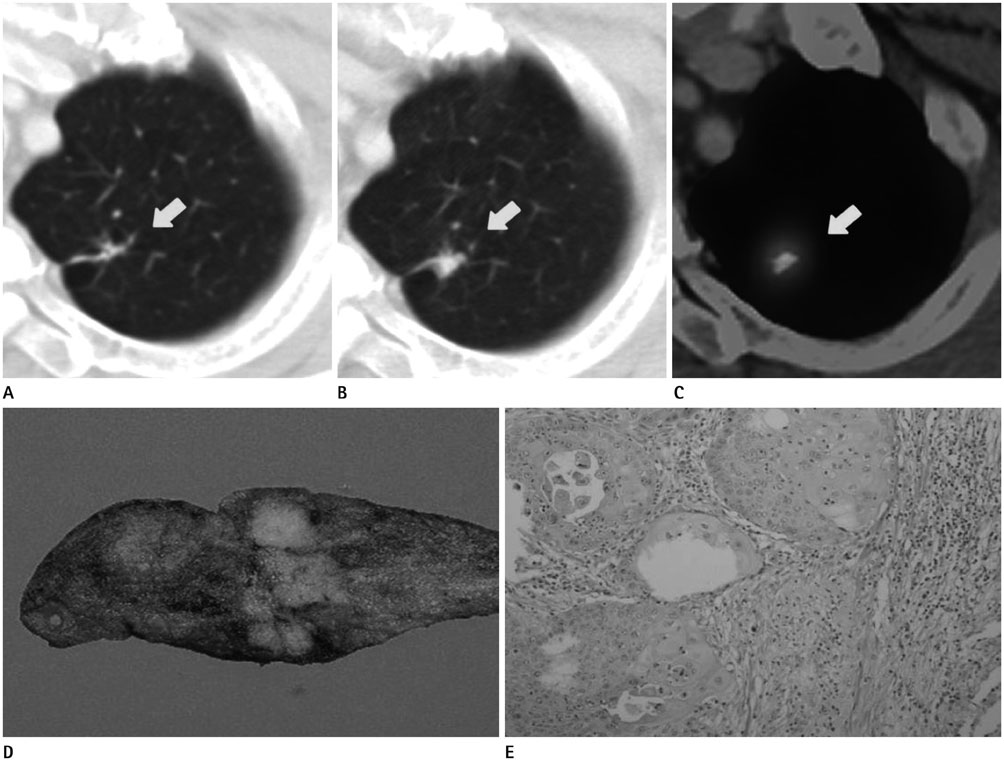J Korean Soc Radiol.
2015 Oct;73(4):225-229. 10.3348/jksr.2015.73.4.225.
Synchronous Triple Primary Lung Cancer: A Rare Case with Radiologic-Pathologic Correlation
- Affiliations
-
- 1Department of Radiology and the Research Institute of Radiological Science, Gangnam Severance Hospital, Yonsei University College of Medicine, Seoul, Korea. park_chulhwan@yuhs.ac
- 2Department of Thoracic and Cardiovascular Surgery, Gangnam Severance Hospital, Yonsei University College of Medicine, Seoul, Korea.
- 3Department of Pathology, Gangnam Severance Hospital, Yonsei University College of Medicine, Seoul, Korea.
- KMID: 2068712
- DOI: http://doi.org/10.3348/jksr.2015.73.4.225
Abstract
- Synchronous multiple primary lung cancer is uncommon. They present at the same time, but are distinct and have different histologic features. Synchronous triple primary lung cancer is rare and only few cases have been reported previously. We described a case of synchronous triple primary lung cancers in an asymptomatic 64-year-old man that showed different radiologic features of lung tumors on chest computed tomography images. Anatomical resection and histological analysis revealed 3 different types of lung carcinoma with radiologic-pathologic correlation.
MeSH Terms
Figure
Reference
-
1. Martini N, Melamed MR. Multiple primary lung cancers. J Thorac Cardiovasc Surg. 1975; 70:606–612.2. Flynn MJ, Rassl D, El Shahira A, Higgins B, Barnard S. Metachronous and synchronous lung tumors: five malignant lung pathologies in 1 patient during 7 years. Ann Thorac Surg. 2004; 78:2154–2155.3. Tokuchi Y, Kamachi M, Harada M, Hasegawa M, Mishina T, Yamashiro K, et al. Synchronous triple lung cancers after treatment for non-Hodgkin's lymphoma: metachronous quadruple cancers. Intern Med. 2003; 42:1031–1034.4. Froio E, D'Adda T, Fellegara G, Ampollini L, Carbognani P, Rindi G. Three different synchronous primary lung tumours: a case report with extensive genetic analysis and review of the literature. Lung Cancer. 2008; 59:395–402.5. Yoon HJ, Lee HY, Han J, Choi YL. Synchronous triple primary lung cancers: a case report. Korean J Radiol. 2014; 15:646–650.6. Chang YL, Wu CT, Lee YC. Surgical treatment of synchronous multiple primary lung cancers: experience of 92 patients. J Thorac Cardiovasc Surg. 2007; 134:630–637.7. Zwirewich CV, Vedal S, Miller RR, Müller NL. Solitary pulmonary nodule: high-resolution CT and radiologic-pathologic correlation. Radiology. 1991; 179:469–476.8. Travis WD, Brambilla E, Noguchi M, Nicholson AG, Geisinger KR, Yatabe Y, et al. International association for the study of lung cancer/american thoracic society/european respiratory society international multidisciplinary classification of lung adenocarcinoma. J Thorac Oncol. 2011; 6:244–285.9. Rosado-de-Christenson ML, Templeton PA, Moran CA. Bronchogenic carcinoma: radiologic-pathologic correlation. Radiographics. 1994; 14:429–446. quiz 447-448
- Full Text Links
- Actions
-
Cited
- CITED
-
- Close
- Share
- Similar articles
-
- Tripe synchronous primary lung cancer: one case report
- Synchronous Primary Lung Cancer with Differrent Squamous cell Carcinoma: One Case Report
- A case report of metachronous triple primary cancers including stomach, bladder and lung
- A Case of Primary Synchronous Lung Cancer
- Surgical Treatment for Multiple Primary Lung Cancer: Report of 2 cases




